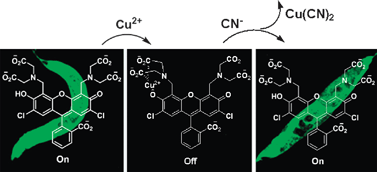A highly selective cyanide sensing in watervia fluorescence change and its application to in vivo imaging†
Abstract
Among the various anions, only cyanide induced the revival of fluoresecence of 1-Cu2+ resulting in “Off–On” type sensing of cyanide, which can be monitored at pH 7.4 in 100% aqueous system, and has been applied to a microfluidic platform, in which fluorescent sensor 1-Cu2+ displayed green fluorescence upon the addition of cyanide, the in vivo imaging of cyanide using Caenorhabditis elegans.


 Please wait while we load your content...
Please wait while we load your content...